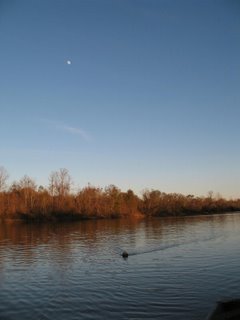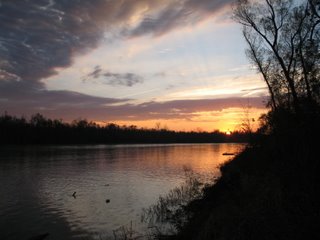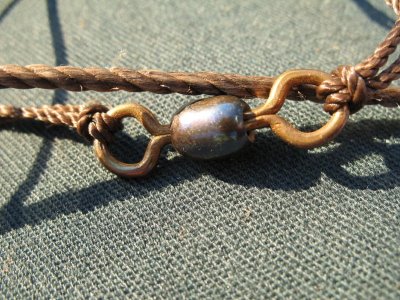New Year’s Eve, 2006
 It has been a good year, this first year of my retirement. A lot of very interesting things have happened, and most importantly there has been time to explore them. You have to have time to watch sunsets and sunrises, and there have been many river sunrises of note, and sunsets too. This picture is sunrise this morning, but showing the western sky for a change.
It has been a good year, this first year of my retirement. A lot of very interesting things have happened, and most importantly there has been time to explore them. You have to have time to watch sunsets and sunrises, and there have been many river sunrises of note, and sunsets too. This picture is sunrise this morning, but showing the western sky for a change. Looking back, I see that I have posted 136 things to Riverlogue since December 13, 2005. The first things were small paragraphs of text that talked about what the days were like here on the banks of the Atchafalaya River. As time went by, I found that I could place pictures into the postings and that added a new dimension. Other things could be done to the blog but I think, for the time being, it works well enough.
 During the last year people have visited this site 6035 times, and through comments they have made I have met people from numerous places in the US as well as other countries in the English-speaking world. People in California ask about Napoleon (birdwatching at the window), and people in England read about the boat project we did and comment about boat making of a similar type in their country. It has truly been a mind-expanding endeavor and enjoyable.
During the last year people have visited this site 6035 times, and through comments they have made I have met people from numerous places in the US as well as other countries in the English-speaking world. People in California ask about Napoleon (birdwatching at the window), and people in England read about the boat project we did and comment about boat making of a similar type in their country. It has truly been a mind-expanding endeavor and enjoyable. The river has had an unusual year this year. What should normally have been a high water season in the spring never took place. And so we have had about 20 months of low-volume flow, unbroken by a strong flushing event. I guess this just puts some extra accent to the saying that there is no such thing as a normal water year. We shall see. One of the unusual things that seems to have happened is the number of salt water species of fish that came all the way up here to Butte La Rose, a long way from salt water. We saw sheepshead, hardhead catfish, gafftop catfish, redfish and tarpon along with the more expected species like flounder and bull shark. I just don’t think of sheepshead swimming under my dock, I just don’t. But thanks to friendly hoopnet fishermen like Rusty Kimball I got to see these fish. And we had a summer of being able to catch blue crabs right here at the I10 bridge. What a great surprise, and man they were so good fresh from the river like that!
One of the very interesting things that time allowed this year was the volunteer work that I do with the state archaeologists. Being a vertebrate zoologist I like to mess with bones, especially t
 rying to identify an animal from a single bone, or even a fragment of one. This activity seems to be useful to archaeologists trying to discover information about Native Americans, information dealing with the sites they occupied and the habits they had, including what they ate. And it turns out that from the bones left in the middens at the sites you can tell something about food habits of the people who ate the animals 2000 years ago. It is fun for me, and seemingly useful to science too – a nice combination. The bone in the picture is related to this in that a friend of mine, Steve Shively, sent me the picture asking for identification if possible. He found the bone beneath an eagle’s nest that he was studying. I confirmed with him that it was a catfish skull. I do the same thing for many of the bones that have lain underground for many centuries. The people you meet who do this kind of thing are interesting too.
rying to identify an animal from a single bone, or even a fragment of one. This activity seems to be useful to archaeologists trying to discover information about Native Americans, information dealing with the sites they occupied and the habits they had, including what they ate. And it turns out that from the bones left in the middens at the sites you can tell something about food habits of the people who ate the animals 2000 years ago. It is fun for me, and seemingly useful to science too – a nice combination. The bone in the picture is related to this in that a friend of mine, Steve Shively, sent me the picture asking for identification if possible. He found the bone beneath an eagle’s nest that he was studying. I confirmed with him that it was a catfish skull. I do the same thing for many of the bones that have lain underground for many centuries. The people you meet who do this kind of thing are interesting too. .jpg) Another thing that time allows is photographing the things that live here along the river, in the place where we live. The inch-long spider lives on our back porch. The books call it a barn spider of the genus Neoscona, an orb weaver. It comes out just after sunset every night (when not too cold) and builds this big web, then waits for food to just fly in. When daylight comes, it “harvests” the web and by sunup there is no web left. I have many other images now of life at Butte La Rose, particularly flowers and invertebrates. Birds take a little more equipment than I have, or want, at least for now.
Another thing that time allows is photographing the things that live here along the river, in the place where we live. The inch-long spider lives on our back porch. The books call it a barn spider of the genus Neoscona, an orb weaver. It comes out just after sunset every night (when not too cold) and builds this big web, then waits for food to just fly in. When daylight comes, it “harvests” the web and by sunup there is no web left. I have many other images now of life at Butte La Rose, particularly flowers and invertebrates. Birds take a little more equipment than I have, or want, at least for now.Just a note about the rain we just had, and a couple of the consequences. We got about six inches here, mostly in about five hours from daylight to noon. There was a lot of standing water, and it filled up the ditches and the big borrow pits along the levee. The frogs are having a really good time out there in that new water! The peepers and chorus frogs are making the nights come alive with the loud announcements of their not-so-honorable intentions toward any friendly female frog that comes within reach. I like to just ride down the road with the windows open so that I can listen to the choruses. All this looks good for the upcoming Louisiana Amphibian Monitoring Program. The survey season starts January 1, with three surveys spaced out over the succeeding six months.
The other consequence of the heavy rains is the rising river. We got about a foot rise very quickly after the rains yesterday. This comes just at the time when the upper Mississippi and Ohio are also feeling the swell of new water in their watersheds, the crest of this rise has made it all the way to Memphis already. But both rivers show lowering water above Memphis. The Atchafalaya River is at 8.0 feet on the Butte La Rose gauge right now, rising to 13.5 feet by Friday, and that’s a pretty hefty rise in a week! The net fishermen will have to move a lot of nets before that water gets here. But they know this.
Rise and Shine, Jim


























